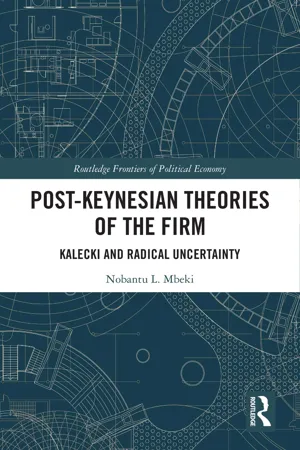
- 472 pages
- English
- ePUB (mobile friendly)
- Available on iOS & Android
About This Book
Within Post-Keynesian economics there is a spectrum of approaches to theories of the firm but what they have in common, to their great benefit, is a proper integration of the concept of radical uncertainty: data that cannot be known. This book revisits Kalecki's theory of the firm is located to show that it constitutes fertile theoretical ground on which to systematically understand the resultant indeterminacy when firms operate under conditions of radical uncertainty. The author proposes a way of generalising radical uncertainty by integrating some of the separate approaches within Post-Keynesian economics centred around Kalecki's work. Through this, it is shown that radical uncertainty does more than just change the ultimate motivation of firms (dropping short-run profit maximisation; more complex motivation; interconnectivity with the environment), it is central to the emergence, existence and motivation of firms, and critically also firm strategy. It is argued that firms do not simply respond to uncertainty: it is the systematic cause of their intentional behaviour. Through developing these arguments, the book also contributes to the methodology of Kalecki and Shackle, as well as Kaleckian price theory. This book will be important reading for anyone interested in theories of the firm, Post-Keynesian economics and heterodox approaches to economics more broadly.
Frequently asked questions
Table of contents
- Cover
- Half Title
- Series Page
- Title Page
- Copyright Page
- Table of Contents
- Acknowledgements
- Introduction
- 1 Radical uncertainty and the limits of mark-up pricing: some further considerations of the question of radical uncertainty vis-à-vis Kaleckian pricing
- 2 An interpretation of the theory of income distribution
- 3 From income distribution towards a theory of the firm
- 4 Pricing and the firm
- 5 Radical uncertainty, the flow of time and the irreversibility of time
- 6 Mark-up pricing and radical uncertainty
- 7 Uncertainty in orthodox and resource-based theories of the firm
- 8 Uncertainty in select competence-based views of the firm
- 9 Towards a theory of the firm
- 10 Existing propositions in the Kaleckian theory of the firm
- 11 The uncertain firm in its uncertain environment
- Conclusion
- Index